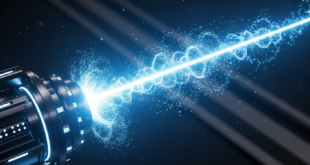Guided missiles work by tracking the moving target’s location in space by specific methods (e.g. using a radar or following its heat signature), chasing it down, and finally hitting it with accuracy. Guidance systems in missiles can be of various types, which serve different operational purposes.
Homing guidance systems control the flight path by employing a device in the weapon that reacts to some distinguishing feature of the target. Homing devices can be made sensitive to various energy forms, including RF, infrared, reflected laser, and visible light. In order to home on the target, the missile must determine at least the azimuth and elevation of the target by one of the means of angle tracking methods.
Semi-Active Laser (SAL) guidance is utilized on the modern battlefield for multiple weapon
systems ranging from rockets to missiles to guided bombs. The SAL guidance scheme relies on
a laser designator to illuminate the target with energy. The reflected light and is then sensed by
the seeker on the weapon system, usually containing a quadrant photodetector, for homing in on
the energy reflected from the target.
Invented in 1960, the laser (light amplification by stimulated emission of radiation) has made a valuable contribution to many modern weapons. Early systems employing laser guidance were the Maverick, Copperhead, and Hellfire missiles which entered service in the late 1970’s. These weapons systems employed semi-active laser homing seekers, operating at a wavelength of 1.06 micros, which are still being used and further developed today. These weapons are said to be semi-active because they do not emit the laser energy that passively they detect and track, in other words, the weapon system does not have a laser source installed but relies on an external laser designator.
Laser Guidance
Laser guidance is used to guide a missile or other projectile or vehicle to a target by means of a laser beam (Lidar), e.g. beam riding guidance or semi-active radar homing (SARH). This technique is sometimes called SALH, for Semi-Active Laser Homing. With this technique, a laser is kept pointed at the target and the laser radiation bounces off the target and is scattered in all directions (this is known as “painting the target”, or “laser painting”).
The missile, bomb, etc., is launched or dropped somewhere near the target. When it is close enough for some of the reflected laser energy from the target to reach it, a laser seeker detects which direction this energy is coming from and adjusts the projectile trajectory towards the source. While the projectile is in the general area and the laser is kept aimed at the target, the projectile should be guided accurately to the target.
However, SALH is not useful against targets that do not reflect much laser energy, including those coated in special paint, which absorbs laser energy. This is likely to be widely used by advanced military vehicles in order to make it harder to use laser designators against them and harder to hit them with laser-guided munitions. An obvious circumvention would be to merely aim the laser close to the target. Countermeasures to laser guidance are Laser detection systems, smokescreen, anti-laser active protection systems.
Laser guided weapons are adversely affected by visibility conditions (clouds, smoke etc) and obscurants. There are also operational limitations on the flight envelopes which have to be flown, exposing aircraft and helicopters to anti-aircraft weapons. When deployed or designated from standoff range, laser guided weapons usually reach the target at flat angles, which do not have sufficient vertical velocity for deep penetration of flat structures (such as underground bunkers). Therefore, such weapons are preferably dropped from shorter distances and high altitude, or through a “loft” maneuver to maintain steep attack angles and high penetration speed.
US DOD requirement
However, the cost of these systems, driven by high quality optics, high sensitivity detectors and specialized electronics, has hampered their migration into gun-fired munitions such as mortars, artillery and grenades. To explore, develop and demonstrate minimal cost solutions, ARL invested in an Army Technical Objective (ATO) called Smaller, Lighter, Cheaper Munition Components (SLCMC). Specifically, SAL seeker hardware, predicated upon commercial components (COTS) and mass production techniques, is being prototyped for use with gun launched projectiles and laser target designators.
At present, the US Army has a very limited inventory of laser-guided, cannon-launched munitions, such as the ‘Copperhead’ laser-guided artillery shell. These precision weapons are typically quite costly and employed at medium to long ranges (i.e. > 3km). As a result, the U.S. Army has the need for low-cost, small, light-weight precision munitions, particularly a low-cost SAL seeker system for use at shorter ranges (i.e. 200m to < 3km).
SAL Seeker Technology
The SAL seeker control system comprises the laser target designation pulse function, seeker front-end laser pulse photodetection, followed by sampling, processor target/mortar model estimation, and flight control actuation. The flight control actuation modifies the projectile flight path, through interaction of aerodynamic forces, to reduce the target-mortar error angles towards zero and so hit the target precisely, in a sampled, closed-loop fashion.
The seeker technology is based on a nose-mounted, near-Infra-Red (near-IR), fixed ‘strap-down’
(i.e. not gyro mounted or gimbaled) SAL seeker using a direct semi-focused laser spot impinging
on a four-quadrant photo-detector. A semi-focused spot on a four-quadrant detector enabled the computation of target error vector (dx, dy) from the mortar bore-sight from the relative laser pulse illumination powers detected on the four quadrants.
The target error vectors (dx, dy) are then sampled and measured at the detection of each of the target reflected designated laser pulses, are input to a micro-controller, for digital signal processing in a flight control algorithm, to control the terminal flight phase of the projectile so as to guide it precisely onto its target by seeking to reduce the target error/offset angles from bore-sight to zero.
Airforce requirement of Next-Generation Focal Plane Array Semi-Active Laser Seeker Algorithms
A number of investigatory projects have shown feasibility of semi-active laser seekers in focal plane array format, leading to new development for single focal plane array, dual mode, and Semi-Active Lasers/Passive seekers.
These seekers will require new algorithms capable of legacy SAL seeker performance in a new focal plane array format. Algorithms such as last significant pulse logic (LSPL) and spot jump inhibit (SJI) may need to be reinvented and tested. Data fusion of the semi-active laser + passive signals may provide new concept of operations, but also require new algorithms.
With the contribution of hardware developers and/or COTS devices, creative concepts are sought which may meet current performance or leverage new hardware capabilities to greater performance. Proposals should describe a basic strategy for acquiring hardware, which may include Commercial Off the Shelf (COTS) components or participation with a prime contractor or other company. The priority is having a platform to demonstrate the relevant advances, it is not necessary that it be in a final configuration. For example, discrete boresighted Semi-Active Lasers/imager devices could be used in place of an imagined future dual-mode singular device.
Proposals should include one of more of the following areas: 1) Mimicry of traditional semi-active laser algorithms onto new FPA-format hardware. 2) Advanced algorithms which may provide more performance when used with next-generation FPA SAL seekers. 3) Data fusion between SAL guidance signal and automatic target recognition. Of secondary interest is other novel concepts which may enable multi-use from a single device, such as autonomous navigation. Proposals including significant hardware development are not desired for this topic.
NSWC Dahlgren Engineers Develop Modernized Low-Cost Semi-Active Laser Seeker reported in April 2022
Engineers at NSWC Dahlgren Division have developed a new, lower-in-cost, semi-active laser (SAL) seeker, the division said April 25.
SAL seekers are a key enabling technology for guided munitions that allow warfighters to target stationary and moving targets in areas where GPS is unavailable. SAL seekers function in tandem with an operator that directs a pulsing, infrared laser at targets. The seeker, typically in the nose of laser-guided munitions, detects the laser energy reflecting off the target and guides the munition to the operator’s mark with high precision. This partnership assures that the correct target is engaged.
The seeker developed by engineers at Dahlgren Division is smaller, three to five times cheaper than comparable laser seekers and is based on modern electronics designs not only to ensure relevance, but also to improve performance and implement the next generation of signal processing and countermeasures. As precision weapons requirements continue to expand, the design is ready to support integration with imager systems. The upgraded terminal seekers will be instrumental in the development of future guided munition systems.
“In response to the shift in force design, warfighting function and the trends going forward, we’re technologically pivoting to stay ahead of the game,” said program manager for the Enhanced Expeditionary Engagement Capability program Luke Steelman.
Traditional SAL seeker systems use a gimbaled detector element to track the laser spot as it moves relative to the weapon. Engineers at Dahlgren were able to develop a new combination of fixed optics and software algorithms to replicate the capability without the need for those expensive and sensitive moving parts. This has not only led to a smaller and more cost-effective product, but also one that is instrumental in ensuring compatibility with the next generation of system currently under development.
What’s more, the new seeker design also includes an integrated height-of-burst sensor that is able to measure proximity to the ground and signal the weapon’s fuze to create a very precise airburst function without the need of an additional sensor on the guided munition, further saving space and reducing cost.
Dahlgren has produced more than 50 prototypes, 30 of which have been live-fire tested on multiple weapon systems — including the 81-mm Advanced Capability Extended Range Mortar — and successfully guided systems to stationary and moving targets. Michael St. Vincent, project lead engineer, said that direct feedback from warfighters was critical to the successful development process.
“We would get feedback from warfighters — what kind of targets they are targeting, what they are like, and also what requirements they need to meet,” said St. Vincent. “If they needed more range or more field of view . . . we would do simulations and make some changes and new iterations that moved closer to what they want.”
Dahlgren has long had a hand in terminal seeker technology, but in recent years the focus of the warfighting function has moved to exceedingly longer-range engagements. These long-range engagements keep warfighters and targeting assets far away from adversaries, but often preclude the use of laser-guided munitions.
Despite increasing engagement distances, Steelman says that laser-guided munitions that use the SAL seeker will always be a mainstay in warfighters’ toolboxes for one reason: target assurance.
“If the operator is putting a dot on a target, he is telling me ‘this is your target, not the one to the left, not the one to the right, that one,’” St. Vincent noted. “Laser guidance will always provide that 99.99-percent assurance that a specific truck or boat is your target.”
References and Resources also include:
https://navalpost.com/naval-missile-guidance-and-homing-systems/
 International Defense Security & Technology Your trusted Source for News, Research and Analysis
International Defense Security & Technology Your trusted Source for News, Research and Analysis


